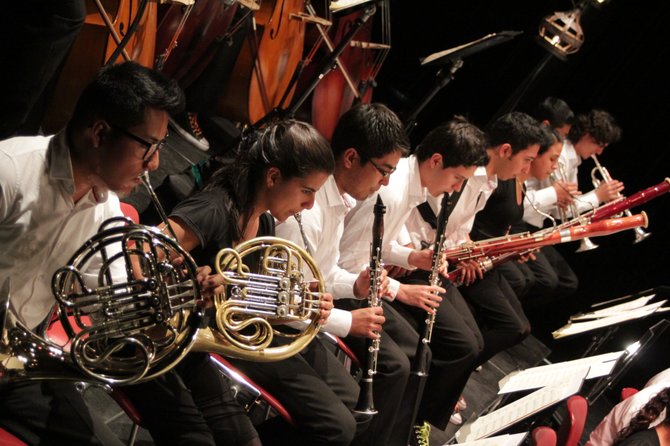Igor Stravinsky’s The Rite of Spring is a visceral, pulsating, raucous, organic, sensual piece of music. In 1913, when it premiered in Paris, it was shocking and groundbreaking. So shocking, in fact, it famously elicited a riotous reaction.
But that was then and this is now. Although its singular aesthetic has held its own, a century of increasingly outrageous and sexually explicit art has dimmed The Rite’s shock factor. It is still thrilling to hear or see a fantastic performance of this piece played and/or danced, but when we settle into our seats, we always know what is coming. Thanks in part to Walt Disney’s romping dinosaurs, Stravinsky’s music has suffered from ubiquity. Even exceptionally exciting performances of The Rite are relatively predictable affairs.
Predictable, that is, unless The Colombian Youth Orchestra is on stage. Last night at the Meyerson Symphony Center, this young orchestra presented one of the most innovative, charming, and riveting performances of The Rite I’ve ever encountered. With the help of a Colombian choreographer who was clearly inspired by Vaslav Nijinsky’s original ballet choreography, the orchestra itself evolved into a living, breathing, dancing organism.
When they weren’t playing, the musicians of the CYO were moving, sometimes subtly, but always evocatively. Percussionists used mallets as tools in a mock ancient ritual as the woodwinds projected Stravinsky’s iconic, mystical opening melodies. The bass players emphasized jerking rhythmic patterns with quick swivels of their large instruments. Violins and cellos warred with one another, swaying back and forth, slowly standing and sitting, waving their bows and raising their instruments above their heads with ceremonious precision. Lighting effects and intermittent video segments with abstract stop-motion animation added to the visual feast. But what made the performance so exceptional was that the orchestra’s sound was as impressive as their choreography. From the first note to the last, dynamics were carefully controlled and rhythms precisely executed. The horns were strong, the strings vibrant, and the woodwinds bright. Their tight cohesion and unity of vision for this piece made the climaxes pop with a fresh, surprising snap.
The Colombia Youth Orchestra is a group of extremely talented 16-24 year olds, many from humble backgrounds, who have been selected through an intense audition process and trained by some of the world’s most elite orchestral musicians. They may wear matching black Converse sneakers on stage, but their playing is tuxedo-level sophisticated. As a member of their staff remarked to me after the concert, “These are the best musicians in Colombia.” Led by an energetic and precise Andrés Orozco-Estrada (who is also the new music director of the Houston Symphony), they play with more maturity than their group’s name implies.
The first half of the concert featured a 2010 work by American composer Gabriela Lena Frank. In a room where most of the music you hear performed was composed by Dead White Men, it was nice to hear the work of a living American woman of Peruvian/Chinese and Lithuanian/Jewish descent. Frank’s Escaramuza also paired well with the Stravinsky. Inspired by native Peruvian kachampa dances, it opens and closes with a booming drum beat. The musicians of the CYO gave it a rhythmically taut, vibrant performance last night.
Sandwiched between the Frank and the Stravinsky, the orchestra performed Shostakovich’s Cello Concerto No. 1 in E-flat Major with guest artist Johannes Moser. A clever pre-recorded video segment introduced the piece by showing Moser in his dressing room, preparing to play before he took the stage. Watching him stretch and warm up connected the audience to the performer more intimately and helped them settle in and prepare for the performance as well.
Moser is a phenomenal virtuoso and he was particularly animated during last night’s performance, playing so vigorously at one point that he snapped a string on his cello. He jumped up and swapped instruments with the orchestra’s principal cellist. It was interesting to watch Moser in the midst of a “make it work” moment as he adjusted quickly to the new instrument. If his performance style is a little flamboyantly over-the-top for my taste, his technique, even on an unfamiliar instrument, is astounding.
The CYO’s performance at the Meyerson last night kicked off the AT&T Performing Arts Center’s new Classical Criterion series. It was a stellar opening to an impressive first season lineup. The house, while not packed, was one of the more diverse audiences I’ve ever seen in that hall. Thanks in large part to education initiatives that offer free tickets to local organizations like Big Thought, the Dallas Music Teachers Association, and the Dallas Greater Youth Orchestra (underwritten by Kaplan), there were more young people in attendance than I’ve ever seen at an orchestral concert at the Meyerson. In addition to racial and socioeconomic diversity, it was great to see some generational variety in that space.
This concert was a success on every front: enthusiastic young musicians who played with great energy, a program that featured new music and a new, innovative approach to older music, a young, diverse audience, and, most importantly, truly superb music making.






